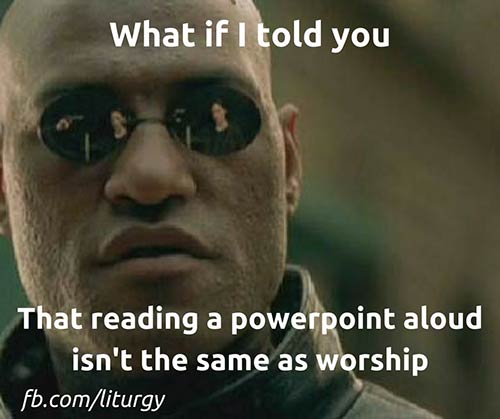
“Do you use a projector?” she asked. Some will remember the days when Anglicans could get a good idea of a person’s worship style by whether he (yes in those days it was a “he”) wore a chasuble. Now, for many people, contemporary worship is determined by the use of a projector screen. No screen – you’re obviously an old fogey, wading through page after ponderous page of some ancient book…
Let me be clear at the outset – I’m not against screens and projectors in worship. I’ve posted here about using them well. But lately I’ve, again and again, seen them used so badly that the assumption contemporary worship EQUALS a projector screen needs serious questioning.
I was in a very new church building complete with two brand-new projector screens. All the service words were projected onto the screen – including the words of the readings. I was about half way down the nave. I’m relatively tall, but I could not see the bottom third to a quarter of the words because of the heads in front of me. Looking between heads from the left screen to the right screen gave me some idea of many words. Anyone shorter than me would have seen much less.
Different occasion; different space: The words for the whole worship song was on a single screen at quite a distance. The central part of the screen had a video of a band playing this song in an enthusiastic service in a country half a planet away, and the sound of that band was fed through the speakers. Many, in the service we were in, didn’t know the song. Many, even of those who did know it, couldn’t read the tiny words on the screen. And then, the primary sense was still spectator: we were mostly watching other people somewhere else, some other time, singing a song.
Third occasion: the person controlling the projector kept being on the wrong slide. There was little sense of deep worship – mostly it was amusement in the congregation every time the wrong slide came up. And then the several worship services where the slides themselves were incorrect.
The paradigm that worship is a poetry recital of interesting words has translated in a magnified way to screen-focused “worship”: endless ‘we say this, now you say that, now he reads this, now we sing that, now we say this and you say that, now she reads this’ is what is taken to be contemporary worship.
And then there is the idol of creativity and novelty. As we, the unconsulted congregation, say our endless words, we can never be sure what the next slide will reveal that we will be proclaiming together.
Then there are the images. Many, of course, breach copyright. Others are at the inane kitten-and-balls-of-wool, clip-art level of depth. Some may be accompanied by a title, e.g. “The Sermon”, as a fatuous placeholder for a regular slot in the service, an image that we have before us during that relatively lengthy period.
And then there are power point devotees who have discovered all the different transitions possible from slide to slide…
Add your stories…
If you appreciated this post, do remember to like the liturgy facebook page, use the RSS feed, and sign up for a not-very-often email, …
Similar Posts:
- None Found




I’ve been in those services which are bad examples of using a projector.
The best use of a projector I’ve seen was at the Cathedral of Hope UCC in Dallas. A very large United Church of Christ (formerly Metropolitan Community Church) congregation of most LGBTQ folks and their families and friends. Today their service is video on demand over the internet. Previously they broadcast the services live over the internet, but that became too costly.
The screens are high so all came see them but without cranking the neck or being blocked by someone’s head. The text very legible from any seat in the house. Because they used to broadcast live, they have a well-trained volunteer television ministry that rarely goofs up.
Prior to the service, the screens are visually running the announcements, plus reminders to turm off pagers, cell phones and the like. And telling parents where child care and children’s worship services are available in the building.
During the services the screens offer the words to hymns and readings when appropriate. Most of the time the screens are offering different points of view of the pulpit and who is speaking. Occasionaly they briefly offer slides that emphasize points in the sermon or audio/visual media that are points in the sermon.
The screens are used for basically everything you would see on your TV screen if you were watching a professionally broadcast worship service on a major broadcast network.
Thanks, David, those are very helpful pointers to using screens well. Blessings.
We desperately need screens which align the direction of worshippers’ faces with the face of the worship leader. Unfortunately church architecture for a different era has led to screens’ “best” placement often making one set of faces at odds to another’s!
Best “screen” for words I have come across recently was at the Equippers church in Dunedin. Behind the band was a projection of imagery on a blank wall (no words, and we wouldn’t have seen them because of the band). But above that imagery projection was a wide, narrow LED (type) screen, stretching more or less the width of the stage (so, 1. central to worshippers gaze; 2. above heads of the band members).
As we sang, each line of the song appeared on the LED screen. Line after line followed sequentially (and perfectly) and I thought it the best projection of song words I have ever come across.
Thanks, Peter, for this suggestion of a positive way forward. Blessings.
BTW, I take issue with Morpheus above. It can be as much worship as reading the words from a prayerbook! It’s in the mind & attitude of those in the act of worship.
I ABSOLUTELY agree with you, David – as I suspect you know. I hope that was clarified in my text – this identifying worship with verbal recitation of poetic words can be part of prayerbook worship (ambiguity intentional). Prayerbook worship does have a lesser element of incessant creativity – but that is present in printed-service-sheet worship as much as screen worship. I might put the Daily Office in a different category; this is a particular style of (very) regular worship which may include three or four psalms in a row and be a lengthy wordy service. Blessings.
Other than the all too common wrong-slide-at-the-wrong-time phenomenon, I remember being at a fairly catholic parish in Queensland where we had ‘The Great Thanksgiving’ up on the screen and I rather naively though we would see the text come up on the next slide. But alas, no: a spinning gold crucifix took away everyone’s attention until the Agnus Dei.
Wow! Robert. That’s worse than websites where the webmaster still thinks that having moving, tacky clipart is somehow cool! Blessings.
Every time I see projection screens, I cringe. They all seem to be trying to emulate 1990’s pentacostal mega churches— complete with the “Jesus is my boyfriend” style of singing.
I went to a Catholic service in the North Valley of Albuquerque (for the baptism of a co-workers baby). They use projection in an extremely tasteful and useful manner. On transept wall space at both sides of the altar, instead of slides being projected, the letters of words were projected in white on the adobe walls. No matter where you sat, you could see them. Only the words you needed to say or sing where projected (as needed). It’s the only time I’ve ever seen projection used where it actually facilitated worship (as opposed to taking away from it and making it feel like an office meeting).
Any time someone talks projection locally, I tell them to go check out what they do. Unfortunately, the Episcopalians/Anglicans who want projection want it 1990’s style, as it’s taken them this long to get OK with the churches moving out of the seventies and into the 1990’s, when they should be trying to meet people where there are now.
http://www.n-bvm.org
Thanks for providing positive ways forward, Vicki. Blessings.
Our general rule of thumb (for screens and lighting) is to be as creative as possible without drawing attention to it.
The”level” of creativity expressed must be in service to the moment, i.e. mimicking the mood of whatever is happening in service.
Our primary objective is to aid the worshipper in their experience, not to be edgy or cool just for the sake of it. We do this in both our traditional and contemporary services though it should be noted that in our traditional, we use more printed liturgies than projected as compared to the contemporary.
Thanks, Ed. It would be fascinating to know more how this works out concretely in practice. Blessings.
I’m from South Africa. We have regular “load shedding ” where power us switched off for an unknown period of time. I’ve been to services where load shedding has occurred and there’s no back up plan. No music books, no prayer books, and the congregation sits looking dazed- no participation. I go to no service without my prayer book.
Fascinating story, thanks, Deborah. Yes, I’ve seen power point where the technology has failed – not just through losing power. Blessings.
I completely agree with you that there are many examples of poor implementations of projection technology in workshop. In the same vein I would say there are many examples of poor implementations of the Prayer Book in worship. (“Welcome to our service. Here’s 1000 pages of script, 98% of which we won’t use today. Before we start please bookmark pages 111, 367, 530, 734 and turn to page 456. Even within that service we’ll only be using half of the words because this is the Church of Or. Good luck. Within 25 years you’ll probably figure us out. Oh, and all the best trying to observe the action in the eucharist while reading from a book – I hope you brought your bifocals.”) Reading from the Prayer Book aloud is not the same as worship.
Technology of any kind (be it book or bulb) does not act as an easy fix. But technology used well it’s a seamless experience that gets out of the way and enables the worshippers to worship.
Some of my favourite, most engaging worship moments have used very little technology from the last 100 years. Others have used a lot.
Churches need to think carefully why and how they worship, and I suggest that the art of curating good worship should not be left to chance.
We are absolutely on the same page, Chris. Blessings.